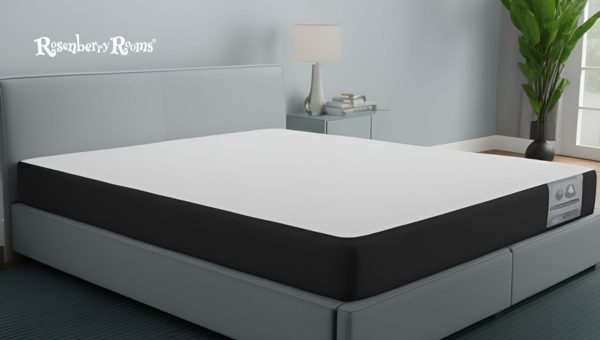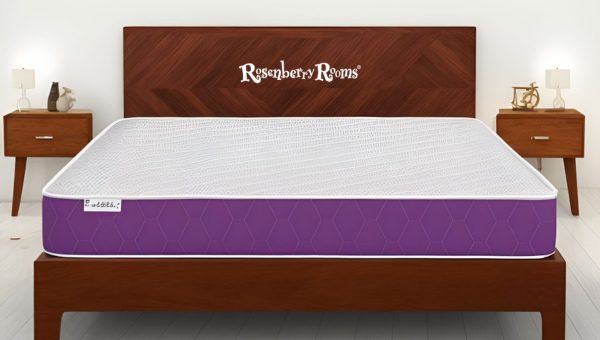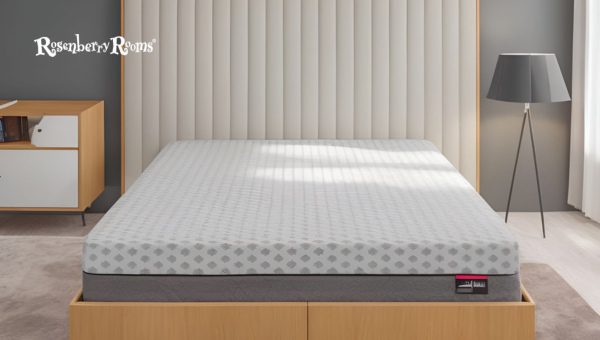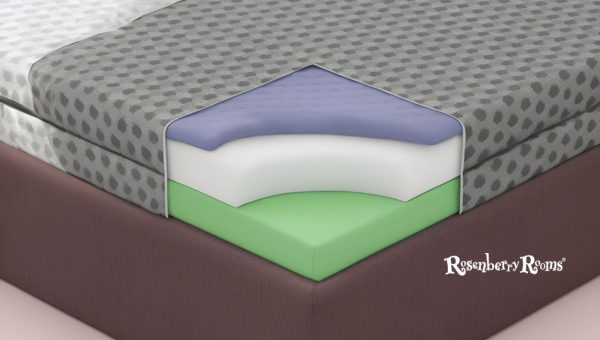Have you ever woken up in the morning feeling more tired than when you went to sleep? Or maybe you've experienced aches and pains that linger throughout the day. Well, it might be that your mattress is the culprit.
But don't fret! An orthopedic mattress could be the perfect solution to ensuring a good night's sleep and reducing unwanted body aches.
It's all about support and accommodation regarding your sleeping surface. And that's precisely what an orthopedic mattress offers.
Crafted with innovative design and advanced technologies, these mattresses work magic to align your spine, relieve pressure points, and drastically improve overall sleep quality.
Now, let’s discover why investing in an orthopedic mattress could mean waking up rejuvenated and refreshed every morning!
Contents
An orthopedic mattress is a high-quality mattress designed to provide support comfort, and help alleviate body pain and stiffness. This type of mattress is perfect for individuals who experience regular back pain as it promotes healthy posture and spinal alignment.
The main features of an orthopedic mattress include firmness, tailored support, pain relief effects, and long lifespan. Known for their therapeutic properties, these mattresses can be made from various materials, including memory foam, latex, or pocket springs.
Each material offers different benefits and levels of support. For instance, memory foam contours to the shape of your body, while latex offers firmer support. Choose an Orthopedic Mattress based on your comfort preference and specific body support needs.
Explore More: Different Types Of Canopy Beds [Top 20 Canopy Beds In 2025]

When getting a good night's sleep, the right mattress plays a pivotal role. Especially for those experiencing joint and back issues, an orthopedic mattress can be a game-changer.
With so many options, how do you pick the perfect one? Let’s break down the essential factors you should consider.
Choosing the right orthopedic mattress involves considering various factors. Researching and understanding these aspects will ensure you make an informed decision, leading to many nights of comfortable and restful sleep.

Orthopedic mattresses are explicitly designed to support joints, the back, and the overall body. When choosing the right orthopedic bed, it's essential to consider the different types available.
Each type offers unique benefits, catering to various preferences and needs. Here, we will delve into two primary kinds: Memory Foam and Innerspring mattresses.
Memory foam mattresses are popular for their body-contouring properties. Made from viscoelastic foam, they respond to body heat and pressure, allowing them to mold to the shape of your body. This provides excellent support for joints and ensures even distribution of weight.
As a result, it alleviates pressure points and can help reduce pain. They're especially beneficial for side sleepers, as they cushion the shoulders and hips.
One distinct feature of memory foam is that it can retain heat, making it a cozy option for colder climates. There are gel-infused variants that are designed to keep you cool.
Innerspring mattresses have been around for decades and are among the most traditional types. They contain coiled springs that provide the primary support. These coils' number, type, and arrangement can vary, affecting the mattress's comfort and support levels.
An innerspring mattress typically offers a firmer feel and good airflow, thanks to the spaces between the springs. This makes them a cooler sleeping surface compared to memory foam. They are also more bouncy, which some people prefer.
One downside to innerspring mattresses is that they might not distribute weight as evenly as memory foam, potentially leading to pressure points.
Latex mattresses are renowned for their durability and natural origin. Made from rubber tree sap, they offer a combination of comfort and support that many find appealing.
Latex can be springy and cushioning, making it adaptable to various sleepers. A distinct feature of latex is its breathability, ensuring you remain cool throughout the night. Being a natural material, latex is often hypoallergenic and resistant to dust mites.
There are two main types: Dunlop (denser and firmer) and Talalay (softer and more bouncy). For eco-conscious consumers, natural latex mattresses offer an environmentally friendly option instead of synthetic variants.
Gel-infused memory foam mattresses are an evolution of traditional memory foam. They have all the advantages of memory foam, such as contouring to your body shape, but come with an added benefit: temperature regulation.
The gel particles or beads infused within the foam dissipate heat, ensuring a cooler sleeping surface. This is especially valuable for those who find traditional memory foam mattresses too warm. The gel also adds a slight resilience to the foam, giving a more balanced feel between softness and support.
As the name suggests, hybrid mattresses combine elements from various types of mattresses, often pairing the supportive coils of an innerspring with the comfort of memory foam or latex. The goal is to capture the best of both worlds.
The base consists of pocketed coils that reduce motion transfer, topped with foam or latex layers for cushioning. This design ensures a balanced feel, offering firm support from the coils and plush comfort from the top layers.
Hybrid mattresses strike the right balance between bounce, support, and pressure relief. They're especially popular among those who can't decide between innerspring and foam or latex mattresses.
A pillow-top mattress offers an additional layer of padding sewn on top of the mattress's primary surface. This soft and plush layer gives the mattress a luxurious, cloud-like feel.
Ideal for those seeking extra cushioning, the pillow top provides immediate comfort, which is especially beneficial for side sleepers who need a softer surface for their shoulders and hips.
Despite its initial softness, the mattress's core can range from soft to firm, allowing various support levels. One thing to note is that the plush top might compress over time, reducing its initial loftiness.
Pocketed coil mattresses, encased or wrapped coils, are a modern iteration of the innerspring mattress. Instead of interconnected coils, each coil is individually wrapped in fabric pockets.
This design results in reduced motion transfer, meaning that when one person moves, the other sleeper is less likely to feel it.
This makes for a peaceful sleeping experience, especially for couples. Additionally, the individual coils contour better to the body than traditional innerspring, leading to better pressure point relief and support. Pocketed coil mattresses often come with foam or gel layers on top, enhancing comfort.
An adjustable air mattress uses air chambers as its primary support system. With the help of a remote or an app, users can inflate or deflate the bed to achieve their desired firmness level.
This customizability sets the adjustable air mattress apart, making it perfect for those with changing comfort needs or couples with different firmness preferences.
Some advanced models even allow different firmness levels on each side of the bed. The top layer often includes foam or a pillow top for added comfort.
While they offer unparalleled customization, ensuring the air pump system is durable and that the mattress is well-constructed to avoid leaks or malfunctions is essential.
Orthopedic firm mattresses are designed with spinal support and body alignment in mind. As the name suggests, these mattresses are firmer, providing a solid surface that promotes a neutral spine position.
They are particularly beneficial for back and stomach sleepers, ensuring the body doesn't sink too deeply. Orthopedic designs aim to alleviate joint pain, muscle soreness, and chronic back issues.
When combined with the right pillows and sleep posture, these mattresses can significantly improve sleep quality and overall bone and joint health.
It's always advisable to consult with a healthcare professional before selecting, especially if one has specific medical conditions.
Organic mattresses prioritize using natural, non-toxic materials, often sourced sustainably. Common materials include organic cotton, wool, and natural latex.
These mattresses are free from synthetic chemicals and flame retardants, making them a healthier choice, especially for those with allergies or sensitivities.
An organic certification can verify the authenticity of the materials, so it's a good practice to check for certifications like GOTS (Global Organic Textile Standard) or GOLS (Global Organic Latex Standard).
Besides being eco-friendly, organic mattresses are more breathable and hypoallergenic, offering a fresh and clean sleep environment.
Egg crate foam mattresses or toppers have a distinctive, convoluted surface that resembles an egg carton. This unique design allows for better airflow, which can help regulate temperature. These mattresses or toppers are typically lighter and more affordable than other foam counterparts.
The "peaks" and "valleys" in the design can offer pressure relief, distributing weight more evenly and reducing the strain on specific body parts.
Egg crate foam isn't always as durable as memory foam or latex. It's often used as a temporary solution or a topper to enhance the comfort of an existing mattress rather than a standalone one.
Orthopedic pillow-top mattresses combine the benefits of orthopedic support with the plush comfort of a pillow top.
At its core, the mattress offers firm and supportive layers that ensure optimal spine alignment and alleviate pressure points. On top of this supportive core is a soft, plush pillow layer that provides immediate comfort and luxury.
This type of mattress is ideal for those looking for firm support and a soft sleeping surface, particularly side sleepers who need cushioning for shoulders and hips. The orthopedic design helps promote better posture during sleep and reduces back and joint pains.
Also Read: Mattress Pad Vs Mattress Protector 2025 [Which Is Better?]
Natural fiber mattresses are crafted using fibers from plants and animals, offering an eco-friendly and often biodegradable option. Common materials include cotton, wool, silk, bamboo, and horsehair.
These mattresses are breathable, moisture-wicking, and hypoallergenic, making them suitable for those with allergies or sensitivities.
They also regulate temperature efficiently, ensuring a comfortable sleep climate. The natural resilience of some of these fibers ensures durability and longevity.
Being devoid of synthetic materials and chemicals, natural fiber mattresses are a greener choice and often come with eco-friendly certifications, attesting to their authenticity.
Orthopedic cooling mattresses are designed to provide both optimal support and temperature regulation. These mattresses are built with materials that promote airflow and dissipate heat, ensuring a cooler sleep surface, which is especially valuable for those who tend to overheat at night.
At the same time, their construction focuses on supporting the spine, joints, and muscles. The combination of cooling technology and orthopedic support makes this mattress type an excellent choice for hot sleepers with chronic pains or those in warmer climates.
Materials commonly used in such mattresses include gel-infused memory foam, breathable latex, and open-cell foams.
Orthopedic plush mattresses strike a balance between comfort and support. While still designed to promote spinal alignment and reduce pressure points, these mattresses feature a softer top layer.
This plush feel is perfect for those who desire the therapeutic benefits of an orthopedic mattress but prefer a more cushioned sleeping surface.
For side sleepers, the plush surface can contour to the body's curves, offering relief to shoulders and hips while maintaining optimal alignment.
Euro-top mattresses are a subtype of pillow-top mattresses but with a twist. The additional padding layer is stitched flush with the mattress's edges, giving it a more uniform and sleek appearance.
Orthopedic Euro-top mattresses combine this design with the benefits of orthopedic support. The result is a mattress that offers a seamless blend of luxury and therapeutic support.
The Euro-top provides immediate comfort, while the underlying orthopedic layers ensure proper spinal support and weight distribution.
High-density foam is known for its durability and ability to offer consistent support over time. An orthopedic high-density foam mattress utilizes this material to provide a solid, long-lasting sleeping surface that maintains spinal alignment.
Such mattresses are less prone to sagging and indentations over time. The high-density foam also provides a firm feel, ensuring that sleepers don't sink too deeply into the mattress, which is vital for those with back issues or requiring stronger support.
Orthopedic low-profile mattresses are thinner than standard mattresses but are specifically engineered to offer the requisite support and alignment benefits.
With a height typically ranging between 5 and 7 inches, these mattresses are ideal for bunk beds, trundle beds, or scenarios where a lower bed height is desired.
Despite their thinner profile, they incorporate materials and design principles that ensure optimal orthopedic support, making them suitable for those who need joint and spine support but have space constraints or aesthetic preferences for a slimmer mattress.

Orthopedic mattresses have become increasingly popular due to their numerous health advantages. Designed specifically to support the body's contours, they play a vital role in ensuring sound sleep and promoting overall well-being. Below, we delve deeper into some of the prominent benefits of an orthopedic mattress.
Read More: Is A Waterbed Good For Back Pain? 2025 [Pros & Cons]
One of the main benefits of an orthopedic mattress is its ability to promote proper spinal alignment. Many people unknowingly sleep in positions that put undue strain on their spine.
An orthopedic mattress's specialized construction ensures the sleeper's spine remains neutral. This helps reduce the risk of spinal deformities and maintains the spine's natural curve.
Another significant advantage of these mattresses is the pressure point relief they provide. Everyone has unique pressure points, like the shoulders, hips, and heels, depending on their sleeping position.
A standard mattress might not cater to these specific needs, leading to discomfort or pain. Orthopedic mattresses, on the other hand, are designed to distribute body weight evenly.
This means they adapt to the shape of the user's body, cushioning and supporting these pressure points. The result is reduced tossing and turning at night, minimizing disturbances and ensuring a more restful sleep.
Orthopedic mattresses are renowned for their enhanced support. Unlike traditional mattresses that might sag or dip over time, orthopedic ones maintain their shape and provide consistent support throughout their lifespan.
They are crafted using high-density foam or innerspring systems that cater to the body's contours. This results in optimal weight distribution, preventing body parts from bearing excessive pressure.
Enhanced support is crucial for individuals suffering from joint pain or muscle aches, as it helps alleviate discomfort and ensure a pain-free sleep.
A lesser-known yet highly valuable benefit of orthopedic mattresses is improved blood circulation. As these mattresses conform to the sleeper's shape, they eliminate the chance of any pressure points getting compressed, which can hamper blood flow.
When the body is aptly supported and there are no pressure-induced obstructions, blood flows more freely, delivering oxygen and nutrients more effectively to all body parts.
Enhanced circulation is beneficial for overall health, aids in faster recovery from injuries, and reduces swelling or numbness that might occur due to compromised blood flow during sleep.
For those sharing a bed, reduced motion transfer is a significant perk offered by orthopedic mattresses. Have you ever been jolted awake because your partner moved or got up during the night? That's motion transfer in action.
Orthopedic mattresses, especially those made from memory foam or equipped with individual pocketed coils, are designed to absorb movement. This means that even if one person shifts or turns, the other remains undisturbed.
Reduced motion transfer ensures both individuals get uninterrupted sleep, which is crucial for healing and overall well-being.
An orthopedic mattress is designed to provide optimum support for the joints, back, and body. Although many users swear by its benefits, it’s important to note that it also comes with drawbacks. Understanding these can help prospective buyers make an informed choice.
One of the most noticeable drawbacks of an orthopedic mattress is its higher cost than other mattresses. Due to the specialized materials and advanced construction methods, orthopedic mattresses tend to be pricier.
While investing in a quality mattress is crucial for a good night's sleep and overall health, the initial outlay can be a deterrent for some.
It's always wise to weigh the benefits against the costs, keeping in mind that a good mattress may save on medical bills over time by potentially reducing the risks associated with poor posture and spinal problems.
An orthopedic mattress provides firm support, which can be a change for those used to softer sleeping surfaces. As a result, there might be a potential for initial discomfort.
The firmness can feel too hard for some users, leading to soreness or pressure points. It's akin to wearing a new pair of shoes; there's an adjustment period.
Over time, the body usually adjusts to this new level of support, but it's important to know that there might be a transition phase.
Individuals should test these mattresses before purchasing, ensuring the firmness level suits their comfort preferences.
Orthopedic mattresses are constructed with denser materials to provide the required support for the body. This density often results in a heavier mattress compared to their non-orthopedic counterparts. The weight can make moving, flipping, or rotating the mattress challenging.
This can concern people living alone or frequently rearranging their bedroom setup. Regular maintenance, like rotating the mattress to ensure even wear, can become cumbersome due to weight.
While orthopedic mattresses are designed to provide adequate support to the body, this focus can sometimes come at the expense of variety in firmness levels. Most orthopedic mattresses lean towards the firmer side.
This limited range of firmness options can make it difficult for individuals to find the perfect balance of comfort and support tailored to their preferences. Those who prefer a plush or medium feel might find the selection somewhat restrictive.
Due to their inherent firmness, orthopedic mattresses may not be the best fit for everyone, especially when considering sleeping positions. Side sleepers, for instance, often require a mattress that can contour their body curves.
The firmness of an orthopedic mattress might cause discomfort for them, leading to pressure points at the shoulders and hips.
While back and stomach sleepers might benefit more from the support of an orthopedic mattress, side sleepers might need to look into specialized options or consider using a mattress topper to achieve the right comfort level.
When first using an orthopedic mattress, some may find that it doesn’t immediately offer the comfort and support they expected. This is because orthopedic mattresses often come with a break-in period, like a new pair of shoes.
During this time, the mattress materials adjust and conform to the user's body shape and sleeping habits. This adjustment phase can vary from days to weeks, sometimes leading to temporary discomfort or dissatisfaction.
New users must be patient and allow adequate time for the mattress to fully adapt before deciding if it's the right fit.
Given their specialized nature, orthopedic mattresses might not be as readily available as standard mattresses, especially in certain regions.
Finding an orthopedic mattress can be challenging in areas where the demand for orthopedic products is lower or where specialized bedding markets are underdeveloped. This limited availability means that individuals might have fewer brands or models.
It might entail longer shipping times or higher shipping costs if the mattress needs to be ordered from a distant location.
For those living in such regions, thorough research and planning become even more essential to ensure they get a product that meets their needs without unnecessary hassles or costs.

Orthopedic mattresses are designed specifically to support the contours of the human body, promoting a healthy spine and relieving pressure points.
To achieve this, these mattresses utilize specialized inner materials, each with unique characteristics and benefits.
Understanding these materials can help individuals decide when to select the best orthopedic mattress tailored to their needs.
Memory foam is a viscoelastic material known for its ability to mold to the body's shape in response to heat and pressure. This contouring ability provides excellent support, helping to distribute body weight evenly and alleviate pressure on joints.
Memory foam mattresses can effectively reduce motion transfer, making them ideal for couples. However, one common criticism is that they can retain heat, which might be uncomfortable for some sleepers.
Advancements in memory foam technology, such as gel-infused memory foam, aim to combat this by offering cooler sleeping experiences.
Derived either naturally from the sap of rubber trees or synthetically produced, latex is another popular material used in orthopedic mattresses.
Latex mattresses are known for their resilience and ability to provide support and comfort. They are naturally hypoallergenic, resistant to dust mites, and offer good airflow, leading to a cooler sleep.
Latex has a quick response time, bouncing back faster than memory foam, and can offer a more "lifted" feel than memory foam's "sinking" sensation.
Innerspring mattresses utilize a coil spring system to provide support. These coils' number, type, and arrangement can vary, affecting the overall comfort and support level.
In orthopedic innerspring mattresses, the coils are often pocketed individually to contour better to the body and reduce motion transfer.
These mattresses are generally more breathable than memory foam or latex due to the air space between coils.
Innerspring mattresses might start to sag, or the springs can become noisy. They're often topped with foam or padding for added comfort.
Also Read About Low Profile Vs Standard Profile Box Spring 2023 [Pros & Cons]
With their specialized design and materials, orthopedic mattresses come in a broad spectrum of price points to cater to various budgets.
The cost can be influenced by factors like the type of inner material, brand reputation, mattress size, and added features.
Shopping platforms like Amazon, Wayfair, and Walmart each offer a diverse range of orthopedic mattresses, with prices reflective of their various options.
By examining the price range on each platform, potential buyers can get a clearer picture of what to expect in terms of cost.
On Amazon, orthopedic mattresses span a broad pricing spectrum. With options starting as low as $100, budget-conscious shoppers can find basic models that provide decent support.
On the higher end, priced up to $1799, buyers can expect luxury mattresses with advanced features, higher-density foams, and extended warranties. This wide range allows for flexibility in choice, depending on individual needs and budget constraints.
Wayfair, known for its extensive home goods collection, offers orthopedic mattresses at around $200. This entry-level price typically covers basic models with standard features.
For those seeking premium options with advanced support systems, cooling technology, or organic materials, prices can soar up to $3699.
The broad range indicates Wayfair's commitment to catering to a wide demographic, from budget shoppers to those seeking luxury.
With its vast retail reach, Walmart presents various orthopedic mattresses suitable for various budget levels. Prices begin at a modest $168, accommodating those looking for affordability without compromising essential features.
For buyers with a higher budget, mattresses priced up to $1700 offer advanced support systems, superior materials, and, often, longer warranties. Walmart's range demonstrates its versatility in meeting the needs of a diverse customer base.
The key difference lies in the level of support. An orthopedic mattress is designed to support joints, bones, and the body overall, while a regular mattress provides general comfort.
Orthopedic mattresses benefit everyone but are especially advantageous for those suffering from chronic back pain, joint issues, arthritis, or recurring body strains.
Although known for their firmness, orthopedic mattresses have different firmness levels to accommodate different sleeper types: side sleepers, back sleepers, etc.
Generally, a good-quality orthopedic mattress should last seven to ten years, depending on its usage and care.
Yes! The primary role of an orthopedic mattress is to align your spine correctly while relieving pressure points on your body, which can improve your sleep quality and reduce overall discomfort.
Better sleep is within your reach, and an orthopedic mattress may be the key. A good lack of sleep doesn't just lead to exhaustion but can trigger numerous health troubles.
With an orthopedic mattress's superior comfort and support, you're taking a meaningful step toward better health.
Your sleeping surface matters. So invest wisely by choosing a mattress that suits your body and promotes healthy sleep patterns. It's not just about the right bed; it's about a healthier, happier you. Remember, your sleep is worth it!